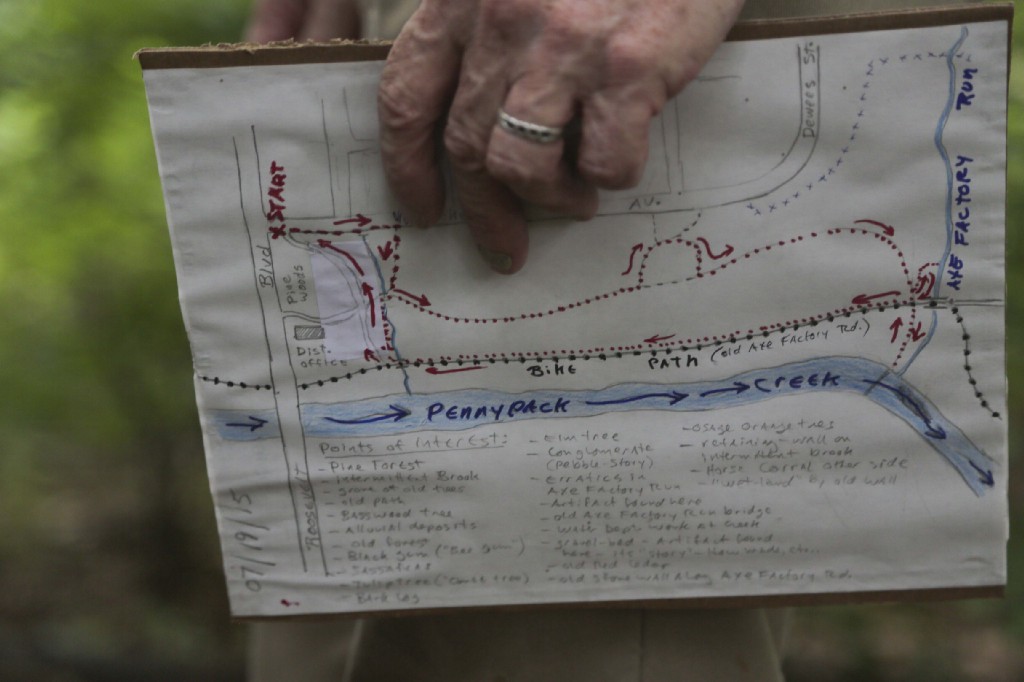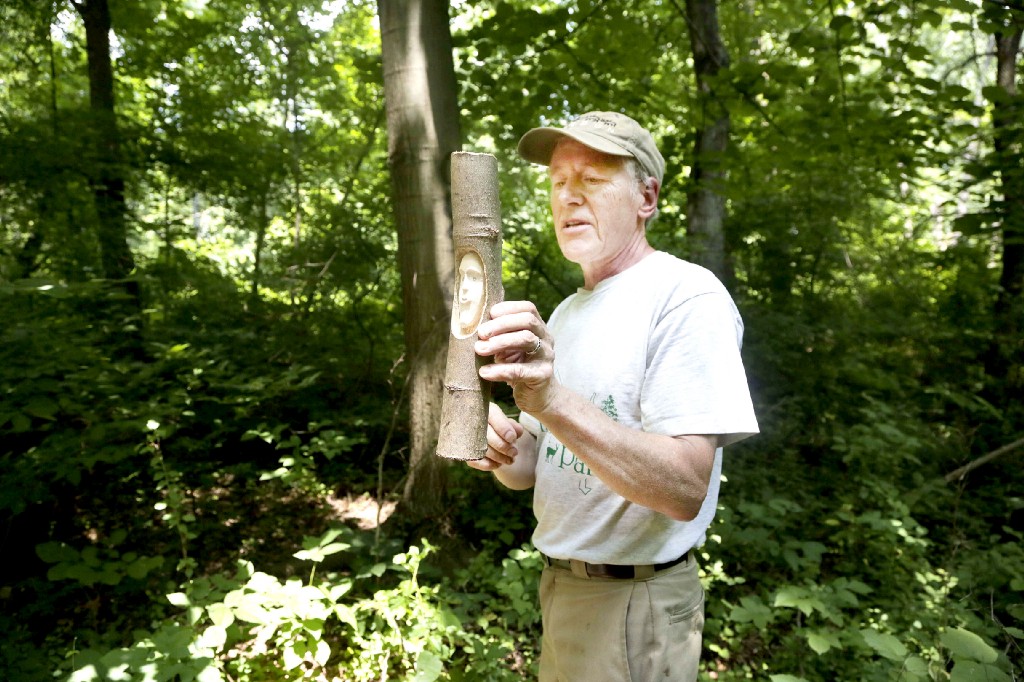
A green adventure: Roland Williams holds a homemade map during last Sunday’s hike. KEVIN COOK / FOR THE TIMES
On one of the most sweltering and soupy days of the year, Roland Williams found something to take people’s minds off the oppressive conditions. In fact, he found many things, all inside Northeast Philadelphia’s very own Pennypack Park.
It should not be surprising to those who know Williams that he and about a dozen friends ended up in the park. The lifelong Northeast resident has spent much of his six-plus decades roaming, studying and combing the 1,750 acres of woods, streams and trails for artifacts large and small, natural and man-made.
He’s turned the pastime into a vocation of sorts, combining an insatiable pursuit of knowledge with his writing, drawing, woodcrafting and other innate talents to become one of the foremost authorities on the lands surrounding the lower Pennypack Creek. In recent months, he’s been sharing that personal passion publicly by leading a series of free nature walks in the park in partnership with the Friends of Pennypack Park, of which he is a longtime member.
Last Sunday, he led a group on a leisurely two-hour trek through a section of the park just east of Roosevelt Boulevard and south of Winchester Avenue, near where the Axe Factory Run trickles into Pennypack Creek. Using natural features, rare relics and models made with his own hands, Williams delivered a bounty of lessons about the area’s natural history and the likely activities of some of its earliest inhabitants.
“I’ve had an interest in all of this since I was a kid,” said Williams, who grew up in Holmesburg and lives near Welsh and the Boulevard, mere blocks from Sunday’s tour route. “For years and years, I didn’t have an outlet for what I knew, until I joined the Friends of Pennypack.”
Williams credits his late father, Jack, with his early exposure to the park. Roland describes Jack Williams, who lived to be 97, as an artist, naturalist and historian in his own right.
After the dormant Friends of Pennypack reestablished in the mid-1980s as a nonprofit preservation and advocacy group, the younger Williams gravitated toward its activities and helped expand them. Years ago, he said, the group held regular nature walks. Various members took turns planning and leading them, including Williams. Some installments were less information-filled than others.
“They just walked around for the walking,” said Sol Stark, 93, recalling some of those earlier hikes.
Eventually the gatherings ceased, but Williams’ curiosity never did. He began writing articles regularly for the Friends group’s newsletter. A couple of years ago, another FOPP member and local historian, Fred Moore, proposed that Williams compile his articles into a single volume. The Friends group sponsored the project, which resulted in the self-published Exploring Pennypack Park. The 124-page paperback is still in print and available by visiting www.friendsofpennypackpark.org
The cost is $10. Ordering details are contained in the online newsletters. Another option is to call 215–934-PARK and leave a message.
Williams builds the nature walks around content in the book.
“A topic might be a particular area of the park, or an ancient tree, geologic feature, historic site - — even a Native American campsite — some place or thing I can take people to,” Williams said.
Sunday’s program began at a park entrance across Winchester Avenue from Calvert Street. A paved, looping road known as Axe Factory Lane offers rare vehicle access there, connecting Winchester to the rear of a park maintenance building and the Greater Northeast Philadelphia Chamber of Commerce office. Williams noted the juxtaposition of the cookie-cutter twin homes on one side of Winchester against the dense woods on the opposite side of the street, a mere several yards away.
Upon entering the park, hikers were greeted by the soothing cool breezes emanating from the shaded green tract, although a secondary natural stream that had once carved through the landscape was dry, a likely victim of nearby urban development.
A few blocks east, near Revere Street, there was a spongy dirt walking path. After a few yards of walking among overgrown wild shrubs and low-hanging tree limbs, hikers arrived at a stand of tall, thick and thriving hardwoods. One tulip poplar seemed to rise 50 feet above the ground with a truck three or four feet in diameter. Williams said it was just the kind of tree that ancient aborigines would use to make dugout canoes. This specimen alone was probably hundreds of years old. The natives would also use the poplar tree’s bark for paneling on their wigwams, prompting one cheeky hiker to observe, “So they were quite popular?”
The group typically spent several minutes or more at each of a dozen or so stops. They were in no rush, moving along at a casual pace, suitable for the seniors in the group, including Stark.
“I’m getting some exercise,” the 93-year-old explained. “It’s interesting. You learn things. (Williams) is very knowledgable. Not only that, he’s very competent, very artistic and a great craftsman.”
Along the way, Williams distributed wildflower seeds and asked hikers to scatter them periodically. Williams said he had harvested the seeds from blue-eyed grass flowers that had sprouted outside his home, leading him to conclude that he had unwittingly picked up the seeds in his boots during an earlier park visit. The flower is an example of many native plant species that may be lost in the park without proper conservation.
Elsewhere, hikers learned about the durable rope and ceremonial masks that can be made from the inner bark of the bass wood tree. They studied the remnants of “chicken of the woods,” an edible fungus. Williams also taught some of the properties of black oak, black gum, osage orange and sassafras trees. Sweet-smelling sassafras root was a highly coveted medicine by early European merchant explorers, who only learned after investing fortunes in the effort that the plant has no healing powers, Williams said. However, it eventually became an ingredient in root beer.
Williams even dabbles in geology during his programs, discussing sometimes mysterious natural phenomena such as erratic or “wandering” stones.
“There’s a lot that I don’t understand, but I try to explain what I do understand,” he said. “But there are a lot of mysteries because a lot of these things happened around the time the Earth was beginning. So they’re mysteries to us.”
Pennypack nature walks are planned for the third Sunday of each month through November. Participants meet at 1 p.m. at a different location each month. The Aug. 16 program will start in the parking lot across Rhawn Street from Holmehurst Avenue. ••

Roland Williams led a group on a two-hour walk through a section of the park just east of Roosevelt Boulevard and south of Winchester Avenue, near where the Axe Factory Run trickles into Pennypack Creek. KEVIN COOK / FOR THE TIMES

Getting in touch with nature: Last Sunday, Roland Williams led a group of nature enthusiasts on a two-hour walk through Pennypack Park. Williams uses natural features, rare relics and models made with his own hands to deliver lessons on local history during the walks. KEVIN COOK / FOR THE TIMES

